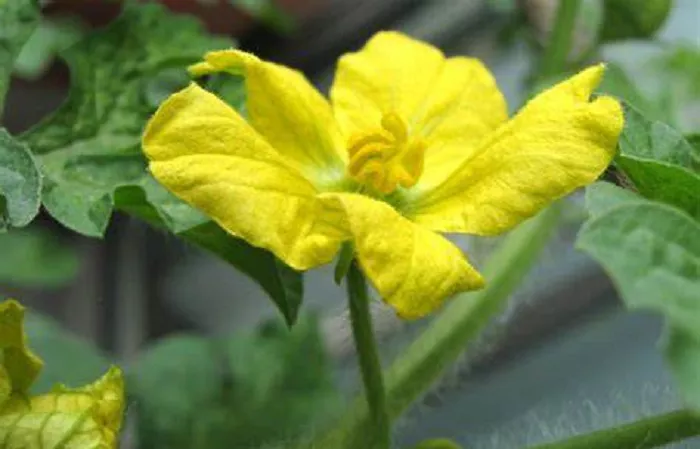Watermelons are a summertime favorite, but many gardeners struggle with pollination. This guide will walk you through the process of pollinating watermelon flowers to ensure a bountiful harvest. From understanding the basics to mastering the techniques, you’ll be well on your way to growing juicy watermelons.
Understanding Watermelon Flower Structure
Watermelon plants produce both male and female flowers. The male flowers appear first and in greater numbers. They have a cluster of stamens in the center, which produce pollen. Female flowers are fewer but easily identified by the small ovary at the base, resembling a tiny watermelon. Pollination occurs when pollen from the male flower reaches the female flower’s stigma.
The Role of Pollinators
In nature, bees and other insects are the primary pollinators of watermelon flowers. They transfer pollen from male to female flowers as they forage for nectar. However, in some cases, gardeners may need to step in and assist with pollination, especially if there is a lack of pollinators in the area.
When to Pollinate
Timing is crucial for successful pollination. Watermelon flowers open early in the morning and close by mid-afternoon. The best time to pollinate is between 8 a.m. and 10 a.m., when the flowers are fully open and the pollen is fresh. Pollinating too late in the day may result in closed flowers and ineffective pollination.
Identifying Male and Female Flowers
Before you begin, it’s important to correctly identify the male and female flowers. Male flowers are smaller and more numerous. They have a slender stem and a cluster of stamens in the center. Female flowers are larger and fewer in number. They have a small ovary at the base, which looks like a tiny watermelon. This ovary will develop into the fruit if pollination is successful.
Manual Pollination Techniques
If natural pollination is insufficient, manual pollination can be a reliable alternative. There are several methods to achieve this, and each has its own advantages.
Using a Paintbrush
A soft, small paintbrush is an excellent tool for manual pollination. Gently brush the stamens of a male flower to collect pollen on the brush. Then, carefully transfer the pollen to the stigma of a female flower. Repeat this process with several flowers to increase the chances of successful pollination.
Direct Contact Method
Another method is to remove a male flower and carefully touch its stamens to the stigma of a female flower. This direct contact ensures that pollen is transferred effectively. Be gentle to avoid damaging the flowers.
Using a Cotton Swab
A cotton swab can also be used for pollination. Dip the swab into the pollen of a male flower and then gently apply it to the stigma of a female flower. This method is precise and allows for controlled pollen transfer.
Ensuring Successful Pollination
To maximize the chances of successful pollination, follow these tips:
Multiple Pollinations
Pollinate each female flower multiple times over several days. This increases the likelihood that enough pollen will reach the stigma and fertilize the ovary.
Weather Considerations
Avoid pollinating during rainy or windy conditions. Pollen can be washed away by rain or blown off by strong winds, reducing the effectiveness of your efforts.
Monitoring Flower Development
Keep an eye on the female flowers after pollination. If the small ovary begins to swell, it’s a good sign that pollination was successful. If the flower withers and falls off, it may indicate that pollination failed.
Common Challenges and Solutions
Even with careful efforts, pollination can sometimes be challenging. Here are some common issues and how to address them:
Lack of Pollinators
If you notice a lack of bees or other pollinators in your garden, consider planting flowers that attract them. Marigolds, sunflowers, and lavender are excellent choices. You can also set up bee houses to encourage solitary bees to visit your garden.
Poor Pollen Transfer
If pollen transfer seems to be an issue, double-check your technique. Ensure that you are collecting enough pollen and transferring it correctly to the stigma. Using a magnifying glass can help you see the pollen grains more clearly.
Environmental Factors
Extreme temperatures, drought, or excessive humidity can affect pollination. Maintain optimal growing conditions for your watermelon plants. Water them regularly but avoid overwatering, and protect them from extreme heat or cold.
Post-Pollination Care
After successful pollination, proper care is essential for the development of healthy watermelons.
Watering and Fertilizing
Watermelon plants require consistent watering, especially during fruit development. Provide about 1 to 2 inches of water per week, depending on weather conditions. Fertilize the plants with a balanced fertilizer every few weeks to support their growth.
Pruning
Prune the vines to remove excess foliage and focus the plant’s energy on fruit development. Remove any diseased or damaged leaves to prevent the spread of infections.
Pest Control
Keep an eye out for common pests like aphids and cucumber beetles. Use organic pest control methods such as insecticidal soap or neem oil to protect your plants.
Harvesting Your Watermelons
Once your watermelons have reached maturity, it’s time to harvest. Look for signs such as a yellowish underside and a dull rind. Thumping the watermelon and listening for a hollow sound can also indicate ripeness.
Storing Watermelons
After harvesting, store your watermelons in a cool, dry place. They can last for several weeks if kept properly. For the best flavor, allow them to sit at room temperature for a day or two before eating.
Conclusion
Pollinating watermelon flowers may seem daunting, but with the right techniques and a bit of patience, you can enjoy a fruitful harvest. Whether you rely on natural pollinators or take matters into your own hands, understanding the process and providing proper care will lead to delicious, homegrown watermelons. Happy gardening!


